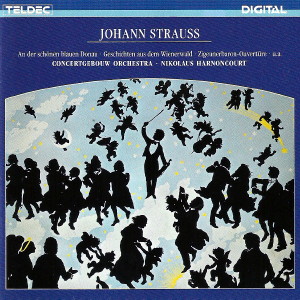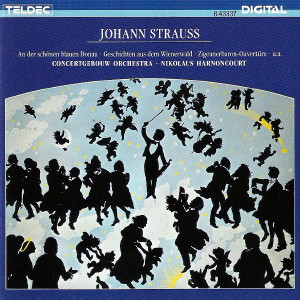 |
1 LP -
6.43337 AZ - (p) 1986
|
 |
| 1 CD -
8.43337 ZK - (p) 1986 |
|
| Johann
Strauss (Sohn) (1825-1899) |
|
|
|
|
|
|
|
| - Ouvertüre zu "Der
Zigeunerbaron" |
8' 01" |
|
A1 |
| - Kreuzfidel, Polka
française, Op. 301 |
4' 03" |
|
A2 |
| - Leichtes
Blut, Polka schnell, Op. 319 |
2' 21" |
|
A3 |
| - Geschichten aus den
Wienerwald, Walzer, Op. 325 |
12' 21" |
|
A4 |
| - Egyptischer
Marsch, Op. 335 |
4' 43" |
|
B1 |
- Wiener Bonbons,
Walzer, Op. 307
|
9' 19" |
|
B2 |
| - Pizzicato-Polka |
2' 57" |
|
B3 |
| - Unter Donner und Blitz,
Polka schnell, Op. 324 |
2' 55" |
|
B4 |
- An der schönen
blauen Donau, Walzer, Op. 314
|
9' 28" |
|
B5 |
|
|
|
|
| CONCERTGEBOUW ORCHESTRA,
AMSTERDAM |
|
| Nikolaus
Harnoncourt, Dirigent |
|
|
Luogo
e data di registrazione
|
| Concertgebouw,
Amsterdam (Olanda) - maggio 1986 |
|
Registrazione
live / studio
|
| studio |
Producer
/ Engineer
|
-
|
Prima Edizione CD
|
| Teldec
- 8.43337 ZK - (1 cd) - 56' 35" - (p)
1986 - DDD |
Prima
Edizione LP
|
Teldec - 6.43337
AZ - (1 lp) - 56'
35"
- (p) 1986
- Digital
|
|
|
Notes
|
Without a doubt
we are moving
towards a reappraisal
of the more sophisticated
light music of the l9th
century. This is the
result not only of a certain deficit
of material that has gradually made
itself felt in the record industry and
concert agencies; not only of the
disappearance of the orchestra from
modern light music - its place has
been taken by the universally
applicable synthesizer. It
is also linked to a new
interest in originality, or rather, in
the original form of a piece of music.
This new awareness has led to the
gradual “rediscovery” of the works of
the Baroque, the Renaissance and even
the Middle Ages as they were heard at
the time. Thus it was only a question
of time before a new look was taken at
the 19th century. Several
of the period’s
major figures, such as Brahms or
Bruckner, have already been subjected
to the limelight, and attention is now
being increasingly given to those
composers whose music has hitherto
been regarded as essentially
functional rather than great art.
When interpreters who want to get to
the bottom of things, like Nikolaus
Harnoncourt, take up this genre,
the produce a completely different
aesthetic picture from what we have
become used to. The main reason is
probably that the piano score, the
arrangement has been the central
source of performing
practice-especially in the realm of
operetta, but the same applied to the
large-scale orchestral waltzes too.
Only now, proceeding in search of the
sound of the original score, have we
arrived at new insights. As we know
from an unbroken tradition that still
exists among Viennese musicians (ditto
the practice between the notes in the
score), original Manuscripts give us
per se a different picture of even the
most popular melodies.
As always, Harnoncourt takes
everything seriously in his
interpretation: notes and pictures,
themes and content. Thus he can’t help
reaching new conclusions. Johann
Strauss suddenly becomes a symphonic composer
who incorporates in his music
orchestral style from Mozart to
Brahms, the oboe culture of Beethoven
and Schubert, and the love of
folk music that had been part of the
Austrian tradition since the Baroque
and culminated in Liszt. Serious
interpretation, then, means treating
the material as a symphonic poem;
understanding the waltz paraphrase as
a sequence of melodic ideas, one
following the other; careful spatial
distribution of the different parts
and attention to the balance of sound,
not only between soloists and
accompaniment (note the horns that can
at last be heard in the grace-notes!),
but also in the dialoque between
different groups of instruments.
“The Gipsy Baron" (1885), Strauss’
homage to this creative minority in
the Double Monarchy, becomes a
concentrated declaration of the
innovative gifts of the Romany
people, which forced all the great
l9th century composers to pursue folk
music material. The “Danube Waltz“,
lirst perlbrmed in 1867, remains an
orchestral piece, although the
composer himself transformed it into a
choral waltz, and in this
interpretation Harnoncourt
reminds us again, as many recent
conductors have failed to, of the
circumstances that inspired Strauss to
compose the unofficial
Austrian national anthem. He didn’t
have a portrait of the Danube in mind,
nori ndeed an ode to
water, but a hymn - corresponding to
the verses of the
socially committed Vormärz
poet Karl Beck which inspired the
title - a hymn to the joie de vivre
that this great river kindles in those
who live on its banks, a reflection on
an imaginary idea of Heimat
or fatherland, whose effect
on people also influenced the form
taken by the waltz chain.
The counterpart to the “Blue Danube”
is the “Tales from the Vienna Woods”,
written a year later: a “pastorale”
in waltz form, a sort of late
successor of Beethoven’s Sixth
Symphony. It
remains unclea rwhether Strauss
intended at musical escape from the
capital, which was becoming
increasingly built-up, or the
rediscovery of idylls whose existence
was only evident to the initiated. The
use of the original zither
melody may be just a
quotation, or perhaps thc elevation of
a disappearing culture as well. The
latter assumption is supported by the
fact that the 44 bars of the first
part of the waltz represent one of the
longest melodics in all music, on a
level with Bach‘s “Aria”, Handel’s
“Largo”, the“Ave Maria” by Schubert,
Wagner`s “Winterstürme“
and the theme of Bruckner’s Seventh
Symphony. The yearning
for another realm of existence knows
no bounds... It is
just this longing, however, that
Johann Strauss formulated
when he placed orchestral beats before
the pianissimi of the“Pizzicato Polka”
(l869) in order to gain the audience`s
attention, when hc
allowed people to hum along to the
orchestra melody in the "Egyptian
March” (1869), when he
constructed miniature polkas, no
matter whether they were
fast or at normal speed.
Nikolaus Harnoncourt’s interpretations
seek out the backround to
these intellectual undercurrents, make
it the subject of the
music. With his Viennese understanding
of expresslon (often brought out
musically in the individual
rubato of the groups
of instruments), he forces orchestra
and listeners alike to participate in
the pictorial associations awakence by
the music. That’s probably
why Johann Strauss sounds quite
different here. He sounds like his
original scores.
Manfred
Wagner
Translation: Clive Williams
|
|
Nikolaus
Harnoncourt (1929-2016)
|

|

|
|